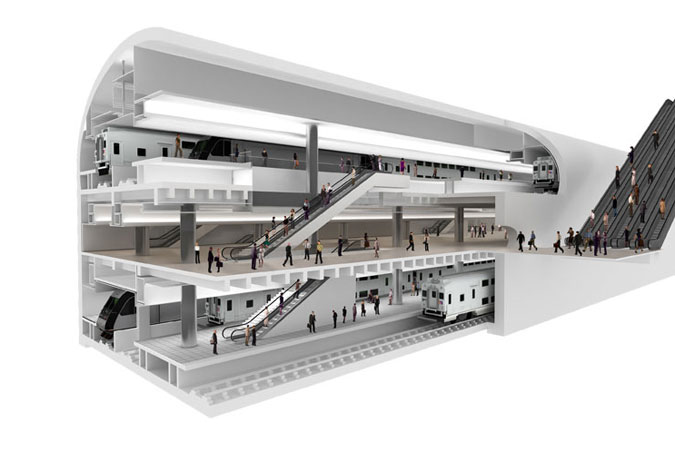
New Jersey Governor Christopher J. Christie’s dumbfounding decision to cancel what is widely seen as the most important public works project in America should be a wake-up call for planners, politicians, and architects who care about salvaging the region’s future amid a climate of professed fiscal prudence and steadily shrinking public enterprise.
Christie’s October 7 move to halt construction of the ARC project—the $8.7 billion transit link between the New Jersey Meadowlands and Penn Station through two new single-track tunnels—shows how short-sighted political tactics threaten to sabotage decades of planning for the public good. While, at press time, the governor had given ARC a two-week reprieve, pending conversations with furious federal transportation officials, this month’s mind-bending scenario offers an urgent lesson for large-scale investments in the region’s fraying transit, energy, and ecological networks.
As we’ve noted here before, the future of architecture and planning in America lies in infrastructure—the sprawling, region-spanning systems that underpin sound design for a densifying planet. The ARC project, with funding from the Port Authority of New York and New Jersey, the federal government, and the state of New Jersey, can be seen as a model of collaborative decision-making and shared vision for the existing 100-year-old trans-Hudson tunnel. Begun in 1995 with the study of 137 different alternatives, the project has involved input from across the spectrum of public leaders, transportation and environmental agencies, and community, business, and labor groups.
But that collaborative vision has been jeopardized by blinkered officials like Governor Christie, who claims that New Jersey can no longer afford its share of ARC costs. Instead, the governor has devised a plan to funnel New Jersey’s $2.7 billion tunnel contribution into the state’s debt-plagued Transportation Trust Fund, where it would presumably be available for road projects and repairs to existing rail lines—precisely the kind of small-bore infrastructural thinking that has kept New York and New Jersey public transit systems in a state of perpetual panic.
One key to reform lies in the way large-scale projects like ARC are administered. Darius Sollohub, director of the New Jersey School of Architecture at the New Jersey Institute of Technology, notes in an op-ed how one hotheaded politician can pull the plug on a multi-agency effort with $600 million already spent and construction under way for more than a year. “The overriding question that future infrastructure planners will ask is how any projects of significant scope can be executed in America today if one individual can stop decades of carefully laid plans,” Sollohub writes. “Whatever the outcome, future planners and legislators will consider whether a governor with the least money on the table should have so much unilateral power.”
That question is particularly acute for the architects, planners, and engineers who are perhaps the only ones with their shirts truly on the line in the ARC project—among them Parsons Brinckerhoff, STV, and DMJM Harris/AECOM, not to mention the construction management team of Tishman, Parsons, and Arup—who bear the brunt of capricious maneuvers like Christie’s, which trade our collective future for a bogus agenda of tough-love retrenchment.